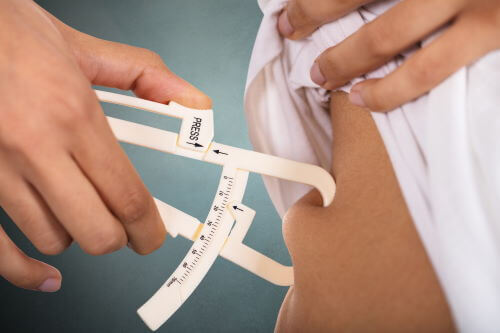What is Lean Body Mass?
If you are reading this, you probably take your personal wellness very seriously.
Working out to achieve fat loss is great, but how does that translate to what you see when you step on your bathroom scale?
Let's go over the basics of what lean body mass is and what that means for you.
See Also: Does Muscle Weigh More Than Fat?

Lean body mass
Lean body mass, or LBM, is your body weight if you did not have any body fat. It is essentially how much the rest of your body composition -- from muscle mass to body water -- weighs.
This is different from your total body weight, which is comprised of both the lean body mass and your body fat weight combined.
Why Is Lean Body Mass Important
Because your lean body mass is the amount your body weighs without body fat, it stands to reason that the higher your LBM, the lower your risk of obesity.
A higher lean body mass also indicates a higher muscle mass and potentially more bone density.
How Does Lean Body Mass Affect Basal Metabolic Rate

Some experts believe that a higher lean body mass level could help you to naturally burn more calories during the day.
Our bodies burn calories even when we are at rest, although at a slower rate than we would if were exercising.
Because muscle burns calories, the more muscle mass we have, the more calories we can burn throughout the day.
Your basal metabolic rate is the rate at which your body expends energy while at rest.
Bodies consume calories as they expend energy, so these two metrics work quite well off of each other. If you were to improve your lean body mass, you should also notice an improvement in your basal metabolic rate.
Lean Body Mass vs. Muscle Mass
So, does LBM tell you how much muscle you are carrying on your body? Well, no. Many people might assume that the opposite of body fat weight is muscle mass, but that's a little bit more specific of a metric.
Muscle mass and skeletal muscle are incorporated into your lean body mass reading, but your LBM also includes body water, bone density, and internal organs.
It is literally the total weight of every part of your body composition if you were to remove your body fat from the equation completely.
Lean Body Mass vs. Body Mass Index
Your body mass index is also different from the lean body mass metric.
While the LBM tells you how much your body would weigh if your body fat were completely removed from the equation, your body mass index is generally considered a way to calculate your body fat percentage.
The body mass index takes a person's weight and divides using the square of their height.
This is then thought to give an idea of your obesity risk, as a higher body mass index is thought to be a sign of a higher body fat percentage and vice versa.
Some health experts warn away from putting too much stock into the BMI, as they consider this metric to be a somewhat inaccurate way to determining your body fat percentage since it does not take your entire body composition into account.
See Also: What BMI is Skinny?
Lean Body Mass Formula for Adults
If after reading this article you believe learning your lean body mass metric could be useful to your overall health, we agree! But how do you go about determining such a specific body composition statistic?
First, determine your total body weight and height. Then, you will use a specific formula to calculate your lean body mass.
Men will multiply 0.32810 by their weight and 0.33929 by their height. Those two results will then be added together. Now subtract by 29.5336.
Women will multiply 0.29569 by their weight and 0.41813 by their height. Once again, the results of these two equations will be added together. The final step is to subtract 43.2933 from this number.
Lean Body Mass Calculator
Do all of those super complicated calculations leave you totally confused? Or maybe you just think they are too much work and hassle? That's OK!
Thankfully, there are convenient lean body mass calculators available online to help you determine your LBM without having to work your way through a difficult math problem.
Simply input your sex, height, and weight, and the lean body mass calculator will do the rest. You will now have a good estimate of how much of your body weight is made up of LBM, versus your body fat percentage.
Measuring

Generally, these measurements are taken by subtracting the body fat from the total weight.
There are a few devices that help with this.
- Calipers: Formerly the gold standard, now quickly becoming replaced by more advanced technology, calipers have been used to measure mid-section body fat. From there, total body fat is estimated and subtracted.
- Hydrostatic Weighing: This is the most accurate method and involves a float tank. Generally, this service is provided by elite sports centers or universities
- DEXA: Dual Energy X-Ray Absorptiometry is also highly accurate and also provides bone density. It is less invasive than hydrostatic weighing.
- BioImpedance Analysis: BIA is an imperceptible electrical signal that measures body fat percentage. It is used in FitTrack's Scales and in most Body Analyzers.
Improving your lean body mass
So, we have figured out what lean body mass is, why it is important for dieters to know, and how to calculate your LBM metric. Now how do we improve our lean body mass and lower our body fat percentage?
It might not come as much of a surprise to learn that consuming protein is often considered one of the most important factors in increasing your muscle mass.
This can be achieved through protein shakes, powders, and simply adding more meat into your diet.
Some experts do believe that the timing of your protein consumption has an effect on the building of your lean body mass, recommending a protein-rich meal or shake in the early evening before bedtime to help carry your body through the night until breakfast.
While you should be increasing your protein intake to obtain more lean body mass, you should be careful to lower your caloric intake overall.
Lowering the number of calories you eat in a day should allow your body to lose fat. But be careful not to reduce your daily calories by too much, as you may see yourself begin to lose muscle mass at that point.
Seek input from your doctor or find an online calculator to determine how many calories to cut from your daily diet to ensure you are still fueling your body while reducing your body fat percentage.
Protein Per Pound of Lean Body Mass Should For Weight Loss.
As already noted, protein is an incredibly important part of your diet, especially when working to increase your lean body mass.
Yet, you do not need to eat an exorbitant amount of protein to see the benefits.
It is recommended to consume 0.7 to 1 gram of protein for each pound of LBM on your body.
This should also help to promote weight loss, especially when eaten in the evening, as your metabolism should be better stabilized throughout the night when protein is consumed before bed.
Why Exercise Is Important
Proper nutrition is only part of the equation when it comes to increasing your lean body mass.
Naturally, exercise plays a key part in reducing body fat percentage and improving your LBM, as well.
Strength training is an obvious choice, as improving your strength goes hand-in-hand with increasing your muscle mass.
There is no need to worry if you are new to exercising, modified versions of standard exercise routines are considered to offer strength training and muscle-building benefits, as well.
For example, if you struggle with traditional push-ups, you could do wall push-ups, instead.
Sources
https://www.pacifichealthlabs.com/Five-Simple-Ways-to-Increase-Lean-Body-Mass-Overview_b_43.html
https://www.livestrong.com/article/391264-how-to-lose-fat-gain-lean-body-mass/
https://www.healthline.com/health/fitness-exercise/how-to-build-lean-muscle#4-ways-to-build-muscle
https://inbodyusa.com/blogs/inbodyblog/lean-body-mass-and-muscle-mass-whats-the-difference/
https://tanita.eu/blog/lean-body-mass-explained/
https://www.sciencedirect.com/topics/agricultural-and-biological-sciences/lean-body-mass







